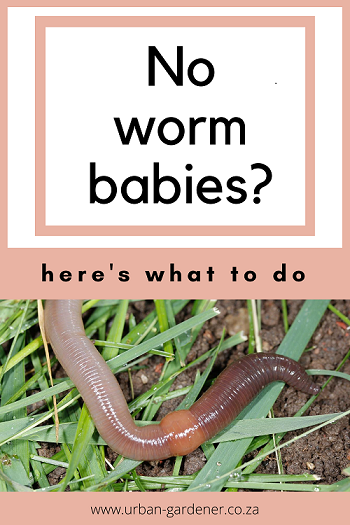This post may include affiliate links where I might earn a commission, at no additional cost to you, should you go ahead and decide to buy anything off this post.
Why Aren’t My Worms Reproducing?
If you find yourself eagerly awaiting the arrival of baby worms in your worm bin but notice a lack of eggs and little wriggly babies, there are a few things happening.
Temperature, seasonality, and worm density can all play a role in worm reproduction.
Red wigglers and compost worms, the common species used in worm farming, tend to breed most actively during the spring and fall seasons.

It’s during these times that you might expect to see swollen clitellums and the formation of eggs in your worm bin.
If you don’t see much of this going on, there could be a problem, but don’t worry – its likely to be easily fixable.
To encourage worm reproduction and ensure a healthy population, always try and make sure you have a healthy worm farm.
There are a few steps you can take in your worm farm management:
How Do Composting Worms Actually Breed?
Conquer Your Worm Breeding Problems
Improve your worm farm reproduction by checking the following:
Temperature regulation: as worms thrive in a range between 55°F and 77°F (13°C and 25°C). Ensure that your worm bin is not exposed to extreme temperature fluctuations or direct sunlight.
Improper feeding practices: overfeeding or providing the wrong type of food, can impact their ability to reproduce. Make sure you are feeding your worms a balanced diet of organic scraps, avoiding excessive amounts of acidic or oily food items.
Density of the worm population: If the bin is overcrowded, the competition levels are going to be high. You’ve heard of Survival of the fittest, right? You may need to transfer some worms to a new bin or tray to give them enough space to do what they need to do, have space and reproduce.
Why am I not seeing eggs and baby worms in my worm bin?
If your worm bin isn’t producing eggs and new worms, something is wrong.
Go through the points I’ve mentioned above, and check each of those potential problems.
(Otherwise, maybe it’s time for a new pair of glasses – after all, the eggs are SUPER small, and just might not be seeing them!)
Conclusion
Worms are cool to have, they break down your food scraps and best of all they make the best compost, aka black gold, you could want for your plants.
Lack of worms is one of the more common warm farm problems, but you can sort it out yourself.
So, you want to keep your worm farm healthy, and your worms happy, so that they will reproduce and in turn, just give you more great compost.
If you’re not seeing babies in your worm bin, you need to find out what’s going on, and its most likely one of the three points mentioned earlier: temperature, seasonality, or worm density. Fix the problem, and you will soon start to see new baby worms in your worm bin.






Recent Comments